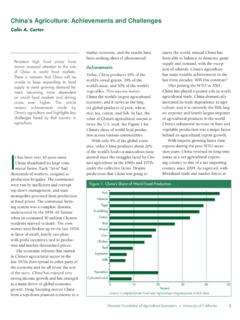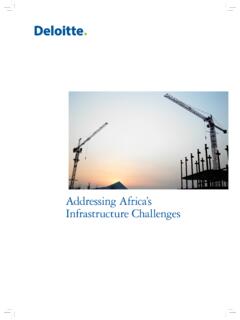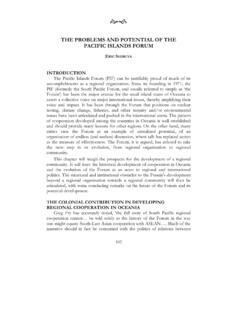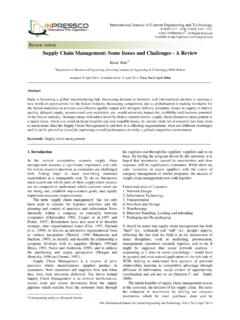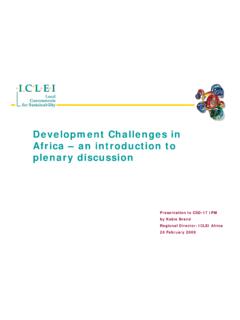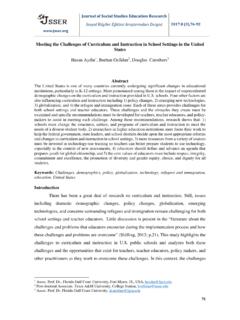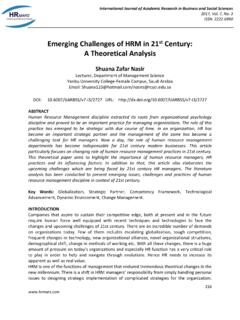Transcription of Statement on a Two-Pillar Solution to Address the Tax …
1 1 OECD 2021 This document sets out the Statement which has been discussed in the OECD/G20 Inclusive Framework on BEPS. 134 member jurisdictions have agreed to it as of 31 August 2021. It is noted that not all Inclusive Framework members have joined as of today. OECD/G20 Base Erosion and Profit Shifting Project Statement on a Two-Pillar Solution to Address the Tax challenges Arising From the Digitalisation of the Economy 1 July 2021 Introduction The OECD/G20 Inclusive Framework on Base Erosion and Profit Shifting (IF) has agreed a Two-Pillar Solution to Address the tax challenges arising from the digitalisation of the economy. The agreed key components of each Pillar are described in the following paragraphs.
2 A detailed implementation plan together with remaining issues will be finalised by October 2021. Pillar One Scope In-scope companies are the multinational enterprises (MNEs) with global turnover above 20 billion euros and profitability above 10% ( profit before tax/revenue) with the turnover threshold to be reduced to 10 billion euros, contingent on successful implementation including of tax certainty on Amount A, with the relevant review beginning 7 years after the agreement comes into force, and the review being completed in no more than one year. Extractives and Regulated Financial Services are excluded. Nexus There will be a new special purpose nexus rule permitting allocation of Amount A to a market jurisdiction when the in-scope MNE derives at least 1 million euros in revenue from that jurisdiction.
3 For smaller jurisdictions with GDP lower than 40 billion euros, the nexus will be set at 250 000 euros. The special purpose nexus rule applies solely to determine whether a jurisdiction qualifies for the Amount A allocation. Compliance costs (incl. on tracing small amounts of sales) will be limited to a minimum. 2 OECD 2021 Quantum For in-scope MNEs, between 20-30% of residual profit defined as profit in excess of 10% of revenue will be allocated to market jurisdictions with nexus using a revenue-based allocation key. Revenue sourcing Revenue will be sourced to the end market jurisdictions where goods or services are used or consumed. To facilitate the application of this principle, detailed source rules for specific categories of transactions will be developed.
4 In applying the sourcing rules, an MNE must use a reliable method based on the MNE s specific facts and circumstances. Tax base determination The relevant measure of profit or loss of the in-scope MNE will be determined by reference to financial accounting income, with a small number of adjustments. Losses will be carried forward. Segmentation Segmentation will occur only in exceptional circumstances where, based on the segments disclosed in the financial accounts, a segment meets the scope rules. Marketing and distribution profits safe harbour Where the residual profits of an in-scope MNE are already taxed in a market jurisdiction, a marketing and distribution profits safe harbour will cap the residual profits allocated to the market jurisdiction through Amount A.
5 Further work on the design of the safe harbour will be undertaken, including to take into account the comprehensive scope. Elimination of double taxation Double taxation of profit allocated to market jurisdictions will be relieved using either the exemption or credit method. The entity (or entities) that will bear the tax liability will be drawn from those that earn residual profit. Tax certainty In-scope MNEs will benefit from dispute prevention and resolution mechanisms, which will avoid double taxation for Amount A, including all issues related to Amount A ( transfer pricing and business profits disputes), in a mandatory and binding manner. Disputes on whether issues may relate to Amount A will be solved in a mandatory and binding manner, without delaying the substantive dispute prevention and resolution mechanism.
6 Consideration will be given to an elective binding dispute resolution mechanism for issues related to Amount A for developing economies that are eligible for deferral of their BEPS Action 14 peer review and have no or low levels of MAP disputes. 3 OECD 2021 Amount B The application of the arm s length principle to in-country baseline marketing and distribution activities will be simplified and streamlined, with a particular focus on the needs of low capacity countries. This work will be completed by the end of 2022. Administration The tax compliance will be streamlined (including filing obligations) and allow MNEs to manage the process through a single entity. Unilateral measures This package will provide for appropriate coordination between the application of the new international tax rules and the removal of all Digital Service Taxes and other relevant similar measures on all companies.
7 Implementation The multilateral instrument through which Amount A is implemented will be developed and opened for signature in 2022, with Amount A coming into effect in 2023. Pillar Two Overall design Pillar Two consists of: two interlocking domestic rules (together the Global anti-Base Erosion Rules (GloBE) rules): (i) an Income Inclusion Rule (IIR), which imposes top-up tax on a parent entity in respect of the low taxed income of a constituent entity; and (ii) an Undertaxed Payment Rule (UTPR), which denies deductions or requires an equivalent adjustment to the extent the low tax income of a constituent entity is not subject to tax under an IIR; and a treaty-based rule (the Subject to Tax Rule (STTR)) that allows source jurisdictions to impose limited source taxation on certain related party payments subject to tax below a minimum rate.
8 The STTR will be creditable as a covered tax under the GloBE rules. Rule status The GloBE rules will have the status of a common approach. This means that IF members: are not required to adopt the GloBE rules, but, if they choose to do so, they will implement and administer the rules in a way that is consistent with the outcomes provided for under Pillar Two, including in light of model rules and guidance agreed to by the IF; accept the application of the GloBE rules applied by other IF members including agreement as to rule order and the application of any agreed safe harbours. 4 OECD 2021 Scope The GloBE rules will apply to MNEs that meet the 750 million euros threshold as determined under BEPS Action 13 (country by country reporting).
9 Countries are free to apply the IIR to MNEs headquartered in their country even if they do not meet the threshold. Government entities, international organisations, non-profit organisations, pension funds or investment funds that are Ultimate Parent Entities (UPE) of an MNE Group or any holding vehicles used by such entities, organisations or funds are not subject to the GloBE rules. Rule design The IIR allocates top-up tax based on a top-down approach subject to a split-ownership rule for shareholdings below 80%. The UTPR allocates top-up tax from low-tax constituent entities including those located in the UPE jurisdiction under a methodology to be agreed. ETR calculation The GloBE rules will operate to impose a top-up tax using an effective tax rate test that is calculated on a jurisdictional basis and that uses a common definition of covered taxes and a tax base determined by reference to financial accounting income (with agreed adjustments consistent with the tax policy objectives of Pillar Two and mechanisms to Address timing differences).
10 In respect of existing distribution tax systems, there will be no top-up tax liability if earnings are distributed within 3 to 4 years and taxed at or above the minimum level. Minimum rate The minimum tax rate used for purposes of the IIR and UTPR will be at least 15%. Carve-outs The GloBE rules will provide for a formulaic substance carve-out that will exclude an amount of income that is at least 5% (in the transition period of 5 years, at least ) of the carrying value of tangible assets and payroll. The GloBE rules will also provide for a de minimis exclusion. Other exclusions The GloBE rules also provide for an exclusion for international shipping income using the definition of such income under the OECD Model Tax Convention. Simplifications To ensure that the administration of the GloBE rules are as targeted as possible and to avoid compliance and administrative costs that are disproportionate to the policy objectives, the implementation framework will include safe harbours and/or other mechanisms.










